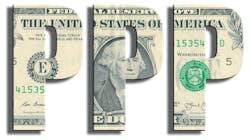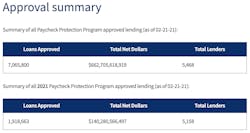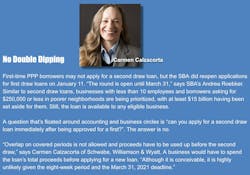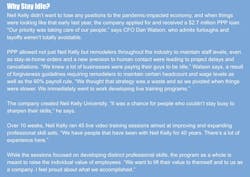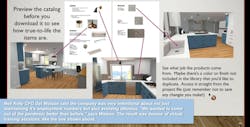The Small Business Administration’s (SBA) Paycheck Protection Program came at a time last year when businesses needed it most—some of the details came later.
Across-the-board pay cuts were planned at Normandy Remodeling when the SBA announced the PPP last spring, and indeed the cuts went into effect—for three weeks until owner Andy Wells and his team were approved for a $1.2 million loan through the program. The pay cuts were reversed and wages retroactively restored.
“The loan came at a time when things were really scary and really unknown,” says Wells, who, with an accounting background, knew enough to understand how serious the financial risks the industry faced were. “Everyone was scrambling for whatever they could get.”
While Oregon was closing schools, Washington was closing the whole state—all activity was stopped. “Remodeling is a constant management of cash between inflows for projects and outflows for booking labor and other trades, and this time was very uncertain,” says Dan Watson, Neil Kelly’s chief financial officer. “Projects halted or canceled in Washington really hampered our cashflow.”
The company’s $2.7 million PPP was insurance against what could have been serious cash problems.
The rub is that while businesses, remodelers included, had their noses pressed to the grindstone flat as a pekingese, lawmakers and financial institutions were disagreeing on how the funds should be treated come tax time—now fast approaching. A late-December COVID-19 relief package promised to address lingering issues with the program while establishing a second draw for the coming year. This new legislation featured revised guidelines and at over . 5,500 pages, is the longest bill ever written—by a lot. Still, suppose a remodeler did work their way through it, they’d still need advisors to decipher the language.
So we talked with the SBA. We talked with remodeling industry and financial experts Dan Watson and Andy Wells. We talked with a direct lender specializing in small business, particularly construction. We tried to talk with the IRS but the response was “speak with a tax attorney;” and so we talked with two, both familiar with PPP.”
We asked these remodelers and experts for clarification, insight, and advice (so far as they are able to provide it). Here are their answers.
Understanding the Second Draw
Included in the latest COVID-19 relief package—signed into law December 27—was the announcement of a second draw for PPP loans, for which the SBAThe current draw closes March 31.
No Public Companies
Kapitus is among the vast network of financial institutions that helped dole out the approximately $522 billion in first draw PPP loans issued last year, and remains a part of that network for this second draw. Though, as Ben Johnston, the direct lender’s COO makes clear, the rules are not all the same.
“What happened last year was some very large, often public businesses jumped the queue because large banks wanted to make sure their large company clients got large loans,” says Johnston. Kapitus averaged a PPP loan size last year of about $150,000 while nearly half of public companies issued PPP loans received more than $1 million and 27 percent more than $2 million. “This time public companies are not eligible to participate.”
New Loan Maximum
Recalibrating the program to better serve the most in-need small businesses was a primary focus in the revisions, he says, as is evident by the public-company exclusion and the at least $25 billion that’s been set aside for borrowers with 10 or fewer employees as well as for loans to businesses in low- to moderate-income neighborhoods, capped at $250,000. The maximum loan size has also been reduced from $10 million to $2 million.
A borrower’s individual loan maximum (so far as it relates to those working in the remodeling industry) is calculated as two and half times a business’s average monthly payroll costs. Borrowers decide whether that average is 2019 or 2020’s.
Revenue-Drop Qualifier
Probably the biggest new disqualifier introduced this draw is the requirement to demonstrate an at least 25% year-over-year reduction in total revenue between any two corresponding 2019-2020 fiscal quarters. In fact, it’s the bar that will keep Normandy Remodeling from applying for a second draw loan. “We considered it but our revenue never dropped enough to make us eligible—which is a good thing,” Wells says.
Basic Eligibility
Businesses that are eligible beyond the mentioned exclusions include those with 300 or fewer employees that will or already have used the full amount of their first draw PPP loan. If the SBA is still reviewing a business’s first draw loan’s forgiveness while an application for a second comes in, it’s not automatic disqualification but it may delay the approval process.
Smaller Congressional Allocation
SBA will continue accepting applications for second draw PPP loans until March 31 or until the money Congress allocated for the draw, $284 billion, is used up.
Kapitus’s Johnston recommends remodelers don’t count on the money lasting through March. “This is barely half of what was allocated over the first two rounds of the initial draw,” he says. Last year the SBA approved about $523 billion in PPP loans. “It’s a real possibility the funds could be extinguished prior to the end of the application period.”
Forgiveness From 8 to 24 Weeks
As far as loan terms, they remain the same as those defined in the first draw. “It’s a straight line amortization, with no payments for the first 10 months,” Johnston explains. “It amortizes to zero from that point over five years,” meaning a person pays it off in five years (lest they suffer consequences outlined by the specific loan’s lender). The SBA’s Roebekr further confirms, “it’s one percent interest over five years.”
More Is Forgivable
What constitutes an eligible expense has also changed—again to the advantage of the borrower. In addition to expenses already approved for first draw forgiveness—payroll, rent, utilities, and business mortgage interest—eligibility now extends to:
- COVID-19-related worker protection expenses, including PPE and facility modifications
- Payments to suppliers who at the time of payment are essential to operations
- Repairs for uninsured property damage caused by looting or vandalism during 2020
- Certain operational expenses that Roebekr confirmed are “payments for any business software or cloud computing service that facilitates business operations, product or service delivery, the processing, payment, or tracking of payroll expenses, human resources, sales and billing functions, or accounting or tracking of supplies, inventory, records and expenses.”
“Most of a remodeler’s business expenses are forgivable,” Johnston says. “Most expenses for most small businesses are forgivable.”
Tax Takeaways
When the CARES Act was passed and the PPP program established, legislators weren’t immediately aware that they’d also created a novel tax conundrum.
Forgiven PPP Funds Are Not Gross Income
“A provision in the Act included language that said that amounts related to forgiveness would not be included in gross income,” says attorney Dan Eller, who also serves as an adjunct professor at Lewis and Clark Law School. Gross income is taxable. “People took that to mean you could receive a loan, get the proceeds, have that loan forgiven without it being tax.”
Normandy owner Andy Wells understood the legislation the same way. “Normally forgiveness of a debt is taxable income, so it was big news that the legislation included that provision,” he says. “It did beg the question, though, of what that meant about expenses paid with a forgiven PPP loan. Deducting expenses paid with a tax-free loan would be a double benefit.”
Deducting PPP-Paid Expenses
The IRS released several updates on the matter throughout 2020, ultimately resolved in their position. “Things seemed most dire,” Keller says, “when the IRS ruled that if a business had a reasonable basis to have their loan forgiven that the expenses paid from it would not be deductible that tax year.” At the time he considered it “the worst possible outcome.”
Congress disagreed with the IRS and in the December relief bill included a clarification. “If you have your loan forgiven, or will have it forgiven,” Keller says, “you can still claim those expenses as deductions in 2020 and beyond.”
Receipts Matter
It’s important that PPP-paid expenses are properly reported come tax time—which wouldn’t be worth saying if the IRS, for half the year, insisted businesses wouldn’t be able to deduct those expenses. “”Businesses should be collecting that information already for their forgiveness application,” Keller says. “But if your CPA explains that we’re not going to be able to count x, y, and z this year, you may not be as careful in your record keeping.”
To the credit of the SBA and Congress, the PPP as both a program and loan is simple in its guidelines and tax treatment.. And while the confusion around deductions may prove costly for a few too lax bookkeepers, as a loan and indeed a safety net remodeler Andy Wells unequivocally recommends it, especially for remodelers.
“I mean, it gave us stability in crazy times,” he says. “I know PPP was meant to help all small businesses, but I think for the remodeling industry it’s just a tremendous opportunity.”
About the Author

James F. McClister
James McClister is managing editor for Professional Remodeler.
